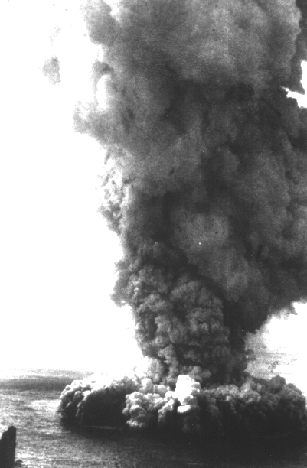 (By D. Burns, 2010)
(By D. Burns, 2010)
Hydrovolcanic eruptions are volcanic eruptions that are generated from the interaction of magma and/or lava with water. Magma rising through the Earth’s crust carries with it a great deal of heat, or thermal energy. If this hot magma comes in contact with water (or ice), either on the surface or in the subsurface, the water can be quickly converted to the gaseous state (steam) via the transfer of thermal energy. This conversion of liquid water to steam is typically associated with a significant increase in the volume of the water molecules (depends on pressure). Because the magma and surrounding country rock can be viewed as a finite space, the rapidly expanding water can cause the surrounding rock/magma to mechanically fail (the rock breaks into fragments). The efficiency of the fragmentation process (i.e. to what degree the surrounding rocks are broken apart) is a function of the confining pressure and the water to magma ratio. The optimum range of water to magma ratios to fuel an explosive event is 0.1-0.3 (Sheridan and Wohlerz, 1983). When discussing hydrovolcanism it is important to be familiar with some basic nomenclature.
Phreatomagmatic refers to the interaction of water with juvenile magma, whereas phreatic or steam explosions simply involving hot rocks and water, and although magmatic heat is likely the source of the thermal energy in the reaction, the deposits do not contain juvenile magmatic material. The pages in this section will discuss various hydrovolcanic structures, processes, and features in an attempt to illustrate and provide an introduction to hydrovolcanic eruptions.
Learn more about the deposits, processes, and landforms associated with hydrovolcanism by clicking the menu button above.
Figure 1. Base surge and eruptive column at Calelinhos in the Azores. Photo credit-R.V. Fisher.